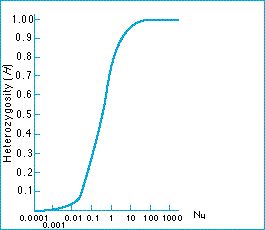Random events in population genetics - How do we calculate the march to homozygosity?

Neutral mutation maintains polymorphism
So far, it might appear that the theory of neutral drift predicts that populations should be completely homozygous. However, new variation will be contributed by mutation and the equilibrial level of polymorphism (or heterozygosity) will actually be a balance between its elimination by drift and its creation by mutation.
Homozygosity will converge to an equilibrial value. The equilibrium is between the increase in homozygosity due to drift, and its decrease by mutation. The expected heterozygosity depends on the neutral mutation rate and the population size. The population will be less genetically variable for neutral alleles when population sizes are smaller and the mutation rate lower.
Figure: the theoretical relationship between the degree of heterozygosity and the parameter Nu (the product of the population size and neutral mutation rate).
| Next |



